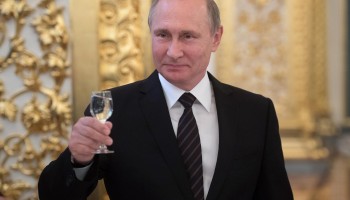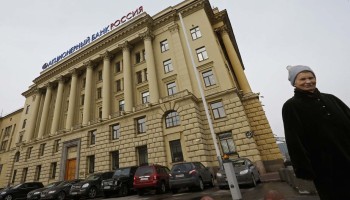Three winters ago, a carpenter from the richly forested Russian region of Karelia embarked on an ambitious snowshoeing trek. In the third week of his journey, as he picked his way through the snow-covered trees that fringe the shores of Lake Ladoga, he stopped to chat with some local fishermen.
Startled by an unusual structure that he spotted punctuating the gray-and-white landscape across the ice, he wondered aloud about the unusually shaped “recreation center.”
The building was a far cry from the usual humble timber huts built by locals. Its wooden walls swooped and curved in all directions, interrupted by large sheets of glass.
The fishermen laughed. The building, they said, was known to everyone around the lake as Russian President Vladimir Putin’s “dacha” — the Russian word for a rural vacation house — and they were surprised the carpenter did not know about it.
Curious to get a closer look, he crossed the frozen inlet on his snowshoes, passed by the house, and kept going. There were other structures on the territory, too, including a traditional Russian sauna — and that was where he was stopped by a security guard. “Caught him by the banya,” he said into his walkie talkie.
The guard told the carpenter he was trespassing on private property and took him to a security post, where his passport information was copied.
When he asked whether the house was indeed Putin's dacha, the guard remained silent. But the strangeness of the encounter had the carpenter convinced that he had stumbled into a place used by the president.
“Starting from the fishermen and ending with the guards, everyone had that special look, as if you know a peculiar secret and can’t help but want to tell,” he recalled.
The peculiar secret of the “Fisherman’s Hut” — as the house was once named on the website of the architecture firm that designed it — has also been probed in several media reports, starting with an expose by television network Dozhd in 2016 that first linked the structure to the Russian president.
Dozhd found that the building and surrounding land belonged to several companies owned by Yuri Kovalchuk, a close Putin ally and the major shareholder of Bank Rossiya, nicknamed “Putin’s Bank” because of its reputation for serving the president’s interests.
But these companies also have another connection, OCCRP found. They are tied to an email domain, LLCInvest.ru, that unites dozens of firms connected to members of Putin’s inner circle. The domain is hosted by a web provider with close ties to Bank Rossiya. And the companies that use it hold billions of dollars in assets linked to Putin, including the Fisherman’s Hut.
OCCRP obtained thousands of leaked emails from two construction companies in charge of developing the land surrounding the building. Their correspondence shows how the LLCInvest companies work together.
The land around “Putin’s dacha” is owned by three different companies whose directors use the LLCInvest.ru domain — Prime, Onega, and Master — as well as one individual, Mikhail Dedov, who also uses an LLCInvest email. But the actual construction of the complex was directed by employees of an obscure nonprofit organization, Revival of Marine Traditions.
From the outside, this nonprofit has no formal or legal link to the Karelian property, and there is nothing in its annual reports that suggests its work includes managing a holiday house. The only clear tie to the other companies is that it’s also linked to the LLCInvest.ru domain.
Other assets linked to Putin — including a vast palace on the Black Sea and another holiday villa in Russia’s northwest — are also managed by companies using LLCInvest emails that seemingly have nothing to do with the properties themselves.
Fire and Water
The leaked emails also contained floor plans, blueprints, interior design plans, and other materials that provide never-before-revealed details on the astonishing luxury of the “Fisherman’s Hut” complex, which is growing to include more than just the distinctive wooden structure featured in the media.
Satellite images show that the construction of the spectacular main house was already in full swing by April 2011. Designed by the Evgeny Mercuryev architectural studio, the building was completed by August 2012 and won several awards for its design.
But the owners of this bayside land didn’t stop with just one “hut.” In 2013, another structure on the site began going up. It was entered into the Russian land registry in 2018 as a “barn,” but judging from the lavish blueprints obtained by OCCRP, its inhabitants are certainly not cows.
The futuristic two-story building features vast indoor-outdoor spaces that look like they were made for entertaining. A spacious open-plan dining area measures more than 200 square meters, separated by a glass partition from a restaurant-style kitchen where guests can watch chefs at work using its grilling equipment, tandoor, Japanese-style teppan, and smokehouse.
The home also has its own private brewery. It’s stocked with 345,000 euros’ worth of Austrian brewing equipment that can produce 47 liters of beer per day.
On the second floor of the building is a tea room with stunning views of Lake Ladoga. On the other side, a glass wall affords a view of the brewery.
Next to the building are two small swimming pools. From the house a small path leads to a natural waterfall that flows into the bay, where there is a cozy secluded gazebo. The waterfall used to be a popular tourist attraction, but now the area is off limits to the public.
It is difficult to estimate the cost of this bespoke facility, but one document showed that in June 2015, the general construction work alone — not including furniture, interiors, or lighting — was estimated to cost 187 million rubles (about $3.5 million at the time).
Farm-Fresh Ingredients for a Vast Kitchen
Most of the nearby land was zoned as farmland until the Fisherman’s Hut was built, and it is largely still used for agriculture.
Next to the Fisherman's Hut is a trout farm. A local resident told OCCRP that you can buy live trout right out of the hands of a security guard at the dacha — if the VIP guests are not on the premises, of course.
The site has also grown to include a cattle farm where steers are raised to produce Kobe beef. But the beef appears to be a more precious commodity than the trout — none of the locals interviewed by OCCRP remembered being able to buy it.
OCCRP reporters managed to reach the director of the company that owns the farms. He said he didn’t know anything about the private villas that surround it — and had no idea that the ultimate owners of the company, and some surrounding properties, were Kovalchuk and his wife.
“Kovalchuks?” he asked with surprise.“Where am I and where are the Kovalchuks? I can tell you about baby trout and the beauties of the Karelia region.”
In 2021, a separate building containing a two-story, 600-square-foot professional kitchen was added to the property. The first floor houses fish, meat and vegetable storage and prep areas with spaces for baking, cold and hot meals. The second floor appears to house kitchen staff, featuring four modest bedrooms with folding beds.
The area is still being developed. In April 2021, activists from a group that advocates for public access to coastlines reported that a new road to the property was being built in Ladoga Skeri National Park, and large-scale logging was underway.
In the summer of 2021 construction started on a new house in the area, also fronting Lake Ladoga, according to documents in the leaked emails. (It is not clear whether it has been completed.)
Although it goes by the modest name “Garden House,” the project is lavish, with interiors made of semi-precious stones like lapis lazuli and labradorite. A large swath of the floor is covered in $110,000 worth of Fior di Bosco marble.
The plumbing fixtures in each of the house’s six bathrooms are projected to cost more than 3 million rubles (around $46,000). A single bidet faucet is priced at 700,000 rubles ($10,800), while a shower handle is estimated at 300,000 rubles (over $4,600).
On the ground floor of the Garden House there are six bedrooms, each with its own bathroom and dressing room. In the center of the building, an indoor pool comes with its own decorative waterfall, flowing from the house’s first floor.
Three architects interviewed by OCCRP described the interior as “premium” and “luxe.”
“You can build such a project only with an unlimited budget,” said one.
“The whole house is covered in semi-precious stone — the sink is stone,” another said. “For me it’s the same category as having a golden toilet,” another said.
According to the leaked documents, a high-end Russian interior design agency, FullHouseDesign, is leading the project. The company’s owner told OCCRP that she has no memory of any such involvement, but took issue with the idea that marble floors were extravagant.
“If you look at our website there are many projects where we use marble floors, as would any other respectable architectural agency.”
She said she could not comment on how much the Garden House might have cost. But a price calculator on FullHouseDesign’s website suggests that the minimum cost would be around 12 million rubles (around $188,000) for the design work alone.
Asked to respond to OCCRP’s findings on the LLCInvest companies, including the ones that own and operate the Fisherman’s Hut, the Kremlin answered only: “The President of the Russian Federation is not linked or affiliated in any way with the assets and organizations you mentioned.”
Local residents told OCCRP the entire bay is usually accessible by road, but gets blocked off by a barrier guarded by federal protection officers when VIP guests are visiting. Local social media groups sometimes publish warnings about the closures.
“Locals serve there as guards only when the site is empty,” one local fisherman told OCCRP. “When high-level guests visit, locals are usually replaced by FSO [federal protection service].”
Even when the bay is open, some said, the large numbers of security cameras on shore discourage visitors.
“It’s scary,” one person said.
In the region of Karelia, meanwhile, the median monthly salary in December 2021 was 64,000 rubles ($860) — far less than the cost of a single shower handle in the bathroom of the Garden House. Still, a local who spoke to OCCRP said he didn’t have a problem with the dacha or its owner.
“I just don’t like it when the road to the bay is closed,” he said.

